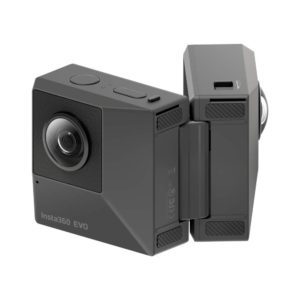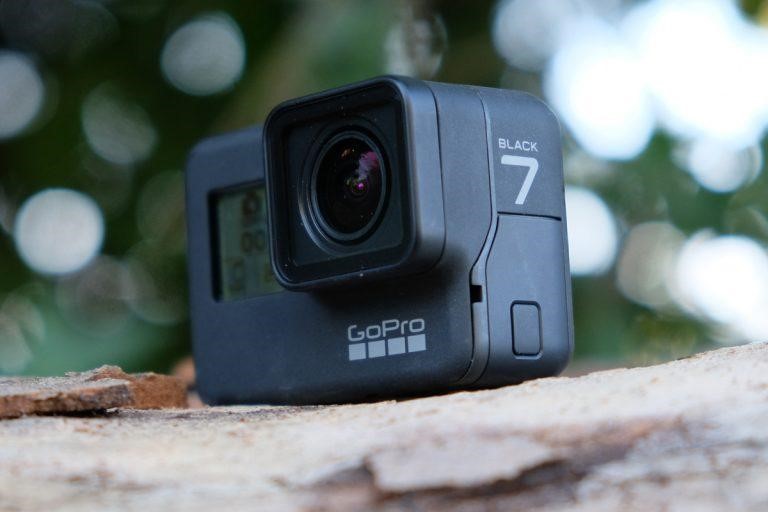IN A HURRY? CHECK OUT Insta360 ONE X TOP PROS:
- Ultra-high 5.7K video resolution
- 6-axis gyro stabilization
- Optional invisible selfie stick
In the past 100 years, the human race has been experiencing a constant technological revolution. These days, every month, or even every day, new technologies are invented to replace existing ones. We live in an era of accelerated technological progress, which means that the things we dreamed of only a few years ago are now real and readily available for us to buy.
During this technological boom, a new type of camera was created – the 360° camera. There are more than 20,500 different camera models already out on the market, with new 360° cameras coming out every month.
With a large variety in cost, features, and design, and with a large collection of cameras on the market, it might be difficult to decide which camera is best for you. This is why we’ve prepared a short history lesson, a buyer’s guide, some tips and tricks, and a shortlist of the best 360° cameras you can find on today’s market.
CONTENTS:
- Before you buy: everything you need to know about 360-degree cameras
- 5 best 360° cameras
- Beginner’s guide to 360 cameras
- 6 beginner tips for 360 cameras
- How we choose these products
| IMAGE | PRODUCT | DETAILS | |
|---|---|---|---|
 |
Our #1 Choice
Insta360 ONE X |
|
Check on Amazon |
 |
Vuze XR |
|
Check on Amazon |
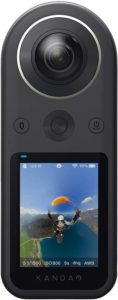 |
Kandao QooCam 8K 360 |
|
Check on Amazon |
 |
Garmin VIRB 360 |
|
Check on Amazon |
 |
GoPro Fusion |
|
Check on Amazon |
Before You Buy: Everything You Need To Know About 360-degree Cameras
Before we get into what you should consider when purchasing a 360 camera, we’ll go over a short history of this technology because we find it fascinating.
A Short History Of 360 Cameras
If you’re a frequent guest on our website, you know we like to talk about the history of the products we review. So here’s a super-condensed history of 360-degree cameras.
Panoramic 360 degree imaging started in England in the early 18th century, when artist Robert Barker used the term ”panorama” for his paintings on cylindrical surfaces. Robert Barker truly opened the doors to the new world of 360-degree imaging. He created an ”endless” painting in the building on Leicester Square in London, where he depicted the city of London in the highest point of the industrial revolution. The artist’s idea was to create a painting that can’t be seen when only looking at one direction, like the traditional paintings.
Not long after Robert Barker’s innovative painting, Joseph Nicéphore Nièpce invented photography. With the invention of photography people became bored of traditional paintings, depicting landscapes. Photography became a huge thing because it displays scenes much more realistically and in more detail than paintings.
Just like paintings, photography was, in the beginning, restricted to a certain scale.
The first panoramic camera invented by Joseph Puchberger was a crank driven swing lens panoramic camera. This camera recorded only a 150-degree field of view. Only a few years after Puchberger’s invention, M. Garrela of England created the first full 360-degree view, and after this invention, 360 cameras started evolving to the 360 cameras we know today.
These days you can find 360-cameras in all shapes of sizes. They vary greatly in their features, specs, and prices. With big brands like GoPro releasing their 360-degree camera models, you know they became mainstream. This fact is further reinforced with big social media websites like Facebook and YouTube now supporting 360-degree videos.
Enough about history, it’s time for us to teach you a couple of things about this amazing technology, mainly what to look for when looking to buy one, and how to use it once you get it.
What to look for in a 360 Camera
The main reason for buying a 360 camera is to take breathtaking high-quality 360-degree images and videos. So, when buying a 360 camera, the focus should be on the features that ensure a clear, high-quality 360-degree image or video.
Stitching
A 360 camera has multiple camera lenses that capture multiple images. After the photos are created, the camera software stitches the photos together automatically. When looking for a good 360 camera, you should focus on the quality of the stitching. A good 360 camera should be able to stitch the images together without leaving visible lines between the pictures. The visibility of the meeting lines between the pictures should be minimized as much as possible to get a clear quality image. Some cameras have software that allows you to stitch the photos together manually, which will help you blend the lines so that they do not look so obvious.
Image and Video Resolution
To match the HD quality of normal images, and videos, a 360 camera requires very high resolution. The required resolution of the video, for a 360 camera, is 4K resolution. Like 1080p is the resolution for standard videos, 4K is the standard resolution for a 360-degree video because 4K resolution ensures HD quality. So, if you are looking for quality photos and videos, the resolution of the video should be 4K or more, and the image resolution shouldn’t go under 15 megapixels.
Stabilization software
If you want to maximize the quality of your 360-degree photos and videos, stabilization software is a must. Whether you want to use your 360 camera while moving, or standing still, software stabilization will help to smooth out most bumps, vibrations and obvious lines on the photo.
What You Can Use a 360 Camera For
Now that you know what you should look for when looking for a 360 camera, let’s go over it’s two most common use cases.
Monoscopic videos and feeds
Monoscopic videos and feeds are flat renderings that are captured by the help of spherical 360 cameras. Spherical 360 cameras are the most common type of 360 media. This spherical camera captures the space that surrounds the user or viewer but does not capture the depth of the space.
The best example of monoscopic videos is mapping applications, like Google Street View. Monoscopic videos can be used in a variety of apps like real estate, image filtering, dating, and many more. That is because of the low prices on the market of some models of 360 cameras.
Stereoscopic Video
Stereoscopic video combines monoscopic images to create 3D renderings of each shot using a separate input for each lense. Stereoscopic video needs to be shot by using two lenses to be suitable to be viewed through a VR headset. The two lenses capture each a 180-degree, or more, angle and than the camera merges the two pictures. Unlike a monoscopic video, a stereoscopic video captures the depth of the space, which makes it appear more lifelike.
Of course, there are many more uses for a 360-degree camera. You can use it to make cool Tiny World photos, or for video streaming. However, we decided to keep it simple and give you the bare essentials, and let you figure out the rest.
The 5 Best 360° Cameras
Now that you know everything about the intricacies of 360° cameras, we’re ready to dive into some actual models currently on the market. We will look at each camera’s weak and strong points and how they hold up against other models.
With a large variety of cost, features, and design, and with a large collection of cameras on the market, it might be difficult to decide which camera is best for you. This is why I’ve compiled a short list of the 360° cameras we find best.
1. Insta360 ONE X
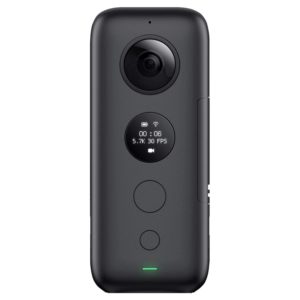
Its miniscule size might lead you to take it less seriously, but make no mistake, it is one of the market’s top models. With its 5.7K video resolution and 18MP still resolution and a 60-minute lifetime, it seemingly has little room for improvement. But it doesn’t stop there!
You can film action scenes worry-free, as its FlowState stabilization works fulltime to stop any wobble from showing up on the footage. And whether you’re shooting stunts or walking around, if you get the optional “invisible selfie stick”, you get to carry it with you without the stick showing up on footage.
The app that comes with the camera provides an editing suite that lets you effortlessly re-point your camera at where the action was, even allowing for time manipulation, giving you a cinematic slow-mo or a stabilized hyper-lapse, all with the tap of a finger.
As we already mentioned, the camera is incredibly small. Its compactness is only emphasized by its sleek and minimal design. Being 4.5 inches tall and about an inch deep and wide, it can easily fit in your pocket. This size constraint does come with a cost: low battery capacity. The physical size of the unit disallows a large battery. Rated at 1050mAh, it reliably holds out for 60 minutes and charges for around 100 minutes.
It has support for Bluetooth and WiFi and allows data transfer over them. Not to worry, though, it has a micro-USB port that allows for super-quick data transfer, letting you get into further editing or viewing your recordings without interruptions. For storage, it uses a MicroUSB of up to 256 GB in size. The manufacturer advises getting a faster SD card that can handle the high data write demands.
Pros
- Ultra-high 5.7K video resolution
- 18MP still resolution
- 6-axis gyro stabilization
- Optional invisible selfie stick
- Expandable battery
- Bluetooth, WiFi and micro-USB connectivity
Cons
- Relatively short battery life
- Isn’t waterproof
Bottom Line
The Insta360 One X was a big leap forward when it came out. Its promise of delivering cutting edge high-quality footage is still true to this day. It’s a perfect 360 camera we’d recommend everyone buy, provided they’re OK with the price.
2. Vuze XR
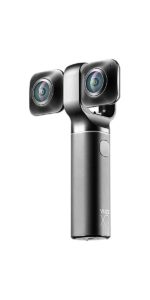
The Vuze XR is a peculiar case: its two cameras can be used separately to shoot 360- and 180-degree photos and videos. With a single button, you can go from 2D 360-degree to 3D 180-degree shooting.
The 2D mode works as you’d expect; the footage from two cameras are stitched together. The 3D mode, however, uses each camera as one of your eyes. Effectively, you’re getting two cameras for the price of one.
The better grip coming from the handgrip is a nice touch and gives you a firm grasp over the camera, so you don’t have to worry about dropping it. Once again, it isn’t waterproof without an extra case. While it might be annoying you can’t take it out on bad weather, the option to expand is definitely nice.
It shoots video at an ultra-high 5.7K resolution at 30 FPS, while stills are at 18MP, neither number shabby. If 60 FPS footage is what you’re after, it can handle it at a lower res of 4K. As an added bonus, it records with four microphones, allowing for 3D sound as well.
The video is saved using H.264 compression and at a bitrate of 120 Mb/sec to a removable Micro SD card. Just like with the last camera, getting an Ultra High Speed Class SD card able to catch up with the data influx is advised.
The camera has a 6-axis gyroscope built in, so that it can stabilize your footage regardless of how shaky your hand was. All this tech is powered by a 1200mAh battery, which should hold out for an hour of operation.
You can connect to it physically over its USB type C port, used for data and charging, or over WiFi. The smartphone app is fairly straightforward to use and provides a video editor. The camera itself supports live streaming.
Pros
- Ultra-high 5.7K video recording
- 18MP still resolution
- 3D 180-degree support
- Video stabilization
- Live streaming support
Cons
- Relatively short battery life
- Isn’t waterproof without a case
- Smartphone app leaves much to be desired
Bottom Line
This camera shares a lot of features with the Insta360 One X and is essentially a watered-down version. Nonetheless, it’s still a very good camera. Its live streaming support, especially, can be a big plus if that’s what you need.
3. Kandao QooCam 8K 360
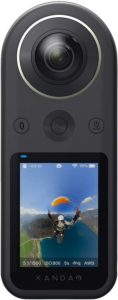
This product is the smallest 8K 360 camera you would find in the tech market. This camera’s resolution is 4times higher than 4K video and 2times higher than 5.6K video. You can choose the vlogging mode to activate SuperCapture. Super capture allows you to pick out the highlights on the screen. You can also choose to live stream with this product, sharing your exciting moments with friends and family.
The notable thing about this camera is the ability to capture real-life events and turn them into incredible slow motion. The camera has advanced stabilization technology that assists you in capturing notable moments in real-time. With this 360 camera, you’re covered for any notable events.
The camera is also able to capture rapid bursts of DNG images. After capturing burst images, the camera would now blend and arrange the images using a powerful algorithm. The camera produces clear, sharp, and clean real-time raw photos.
The QooCam camera has a 2.4″ touch screen display that allows you to preview, playback, and adjust parameters on the screen in real-time. The QooCam app allows you to swiftly edit footage.
It’s possible to customize the shooting preset. This means you can customize your favorite outdoor and indoor events by switching to whatever mode you prefer. You don’t get to miss out on any exciting moments.
Pros
- Ultra big battery: It supports charging while shooting.
- High-Speed internal storage(64 GB)
- Portability and comfort: Fits easily into the back pocket for ease of travel.
Cons
- Poor external microphone.
Bottom Line
It’s a good camera to have. The quality of photos and videos is all good. It offers value for money. The only downside is the quality of the microphone. Although you can always get a quality external microphone for around $20. There have also been reports of the camera overheating while in use. We recommend using a power bank when in use. Overall, it’s a great camera, but it might not be suitable for beginners.
4. Garmin VIRB 360
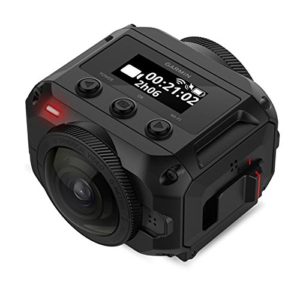
Unlike all previous cameras, the Garmin VIRB 360 is more action-oriented. It is waterproof up to a depth of 10m (about 33 feet). Its rugged design is a testament to its toughness. It comes with clip-on cradles which can be used to mount it on a regular tripod and a GoPro mount.
It sports a monochrome screen and three multi-function buttons that you can use to operate it. Alternatively, you can use the VIRB app as a remote control and real-time footage viewer. It can also stabilize and add data overlays to your videos.
It has a bunch of sensors such as a GPS tracker, a barometer, and an accelerometer. Using info gathered from these sensors, it can calculate your speed, altitude and measure your heart rate if you have the right accessories. With its G-Metrix technology, it can then incorporate this info into an overlay to your videos through augmented reality.
The camera can handle recording up to 5.7K at 30FPS and can take stills of 15MP. It has manual camera controls. It saves at a bitrate of 120 Mbps to a MicroSD card. The camera supports SD cards of up to 128 GB in size. Once again, a high-speed card is preferrable.
The camera can stabilize your footage (if recorded at 4K or under) and give you a smooth shake-free video. It can also automatically stitch 360 video in-camera, though only up to 4K. Any resolution higher than that, and you’ll have to do it yourself, either manually, or using VIRB’s apps for it.
The camera supports 360 audio by using 4 built-in microphones. It also utilizes these mics to provide some minimal voice controls to start and stop recording. All this hardware is powered by a standard lithium-ion battery, with an estimated lifetime of an hour and 5 minutes.
You can connect to the camera over Bluetooth, WiFi or ANT+. You can also use a USB cable. The camera supports live streaming to many popular platforms.
Pros
- Ultra-high 5.7K resolution
- Waterproof up to 10m of depth
- WiFi, Bluetooth, and ANT+ wireless connectivity
- Many sensors and AR overlay
Cons
- Stitching needs manual work at 5.7K
- Very large price tag for little improvement
- Stabilization doesn’t work at 5.7K
- Visibility of fringing at stitch seams
Bottom Line
This camera is a strong contender in resolution size. However, when it comes to features, most other cameras at the same price outcompete this cam. It is more geared to the adventurous folk that need it to be waterproof and ready for action. Its steep price tag, however, can be discouraging.
5. GoPro Fusion
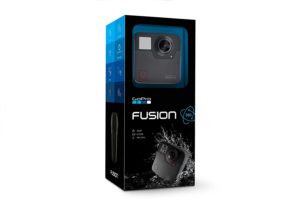
GoPro is a company known for its high-powered action cams, able to withstand come rain or shine. Their delve into 360 cameras gave us the GoPro Fusion, an entry-level 360 action camera.
The maximum supported resolution is 5.2K, and with their feature called OverCapture, you can cut down regular Full HD movies out of your spherical footage. The other special feature – the QuickCapture button – allows you to instantly start recording, even if the camera is turned off.
Control and post-production can be done with the companion smartphone app or the GoPro Fusion Studio program, which can be downloaded for free.
As nearly all other cameras we listed, this camera has 360 audio, by using 4 different microphones. It also has wind noise reduction through the companion PC app, alongside other colors and special effects, such as fisheye and small planet. Just like Garmin VIRB, you can use voice commands to control your recording.
It’s waterproof to a depth of up to 5m (16ft) which, depending on your diving expertise, may or may not be deep enough. The camera does its best to stabilize your video, and it does it very well. It does have some issues with stitching when parts of the camera are submerged underwater. Although a minor issue, you should watch out how you’re holding it if you’re recording something on the surface of the water.
The camera requires you to insert two matching MicroSD cards, which makes transfers to computers very tedious.No official specs regarding maximum size or supported file systems can be found, but I’ve found exFAT works fine. Similarly, no official specs regarding the battery can be found. Through experience, we can tell you that every model works for about an hour at a time.
Pros
- Very high recording resolution of 5.2K
- Waterproof up to 16ft
- Satisfying companion apps
Cons
- Not a very sturdy action cam
- Dual SD card storage
- Fairly high price tag
Bottom Line
If you’re looking for a trusted brand or a cheaper reliable action-ready 360 camera, this might be the one for you. It has everything you need for a camera and the added waterproofing and stabilization is very nice. Being an action cam, though, its build is not the sturdiest and probably can’t take blows well.
Beginner’s Guide to 360 Cameras
360 cameras offer a new and unique take on photography. You can film immersive 360-degree photospheres to ever-fascinating Tiny Planets.
However, filming in 360 degrees has a bit of a learning curve. Even worse, some cameras are even inoperable by beginners.
To help you make your transition to 360-degree filming as painless and possible, we’ve prepared this guide.
We’ll show you the basics, from getting your camera setup to sharing your creations on social media. We’ll keep to the general advice because if we get into detail, this article would be 100.000 words long. For more in-depth guides, we recommend you check out numerous forum posts and video tutorials.
Setting up the Camera
Although you can use your 360 camera independently, it is preferred to use it in combination with your smartphone. Not all cameras come with dedicated apps, but if they do use one, we recommend you stick to it because you will have access to all camera features.
If you run into any issues, it is often easier to delete everything and start over. In most cases, you won’t have to delete the app, but you will have to go through your phone’s Bluetooth and WiFi settings and delete everything associated with the camera. This will essentially reset, allowing you to start fresh, and will save you time and unnecessary stress.
If that doesn’t help, you can reset the camera to factory settings. We can’t tell you how many hours we spent trying to connect cameras just to have to delete everything on it and start over, which usually solves all issues.
After you’re done resetting and deleting everything, you should be ready to go. Just like with any other camera, you can start adjusting things like exposure, shutter speed, and so on.
One more thing before we continue.
You should also see if your 360-degree camera comes with desktop software. Most of them do, and in most cases, they do the same thing the smartphone app does. However, in some cases, you won’t be able to fully edit your videos and photos without the desktop app.
Taking Photos, Shooting Videos
Taking 360 photos and videos is quite different from normal photography. There are no angles and framing to speak of. If you want to capture a scene you like, just hold up the camera and snap the shutter.
If you want to make really compelling 360 photos and videos, you will have to think about placement. Placement is key when it comes to 360-degree photography.
Finding a perfect spot is absolutely vital, so you have something interesting to show. Pay attention to both things in the near proximity of the camera, and far away. There’s no point in filming/photographing something close if you don’t have a bland background.
Finding a good place to set up your camera can be exceptionally challenging since the best places lack a flat surface on which you can place it.
Unfortunately (or fortunately, depending on how you look at it), the best places are most of the time the busiest. You will often find yourself in a crowd of curious people staring at you, trying to figure out what you’re doing.
If you want to make Tiny Planets, you’re presented with a whole new array of challenges. The middle important becomes key because anything tall next to the camera will be spiking off the little world. Sometimes this is just what you want, in other cases, it will make the photo impossible to take without cropping.
We recommend you go around and take a bunch of photos/videos to get familiar with the camera and figure out what works well. When you first start out, and you find a place that’ll make a good photo, we recommend you spin around, so you get an idea what’s around you. Standard photo practices will help you as well.
Videos are another story. You’ll have fewer issues with filming since it’s understood you’re moving around in space.
Editing
Early days of 360-degree cameras are similar to the wild west. Software required for editing the 360 content was scarce. To make matters even worse, most of the available software was janky at best, and couldn’t reliably process the content.
These days things are much different. Most brand name apps will preserve the metadata, and Facebook, Youtube, and such will automatically identify the content as 360 and post it as such.
A few years back, Adobe added 360 photo editing support to Photoshop. And, this is, by far, the easiest way to edit 360 photos. Besides the standard image adjustments you can make, you can also remove unwanted objects such as tripods, people, and processing artifacts.
When it comes to videos, most 360 cameras come with their own software that allows you to trim the videos. Some of these even have the option of combining multiple clips into one video. Adobe Premiere will treat 360-degree videos as plain flat video, so you can edit, color correct, and export them as normal. You can also find plugins for certain models as well. However, talking about them will take us beyond the scope of this article.
We mentioned Adobe software in this section because it’s well known and usually works without a hitch. Other photo editing software should also work, but they lack in features.
We recommend you don’t crop the images at all. Cropping images might confuse the website you’re uploading to, making it unable to figure out you’re posting a 360 image. The most common reason for this is editing software removing the image’s metadata, which identifies the camera type. You might be able to restore the metadata, but in most cases, it’s just easier to use the proper software.
Tiny World Photos
Some 360-degree cameras come with a cool mode that lets you create Tiny World photos. The mode is usually enabled via the camera’s menu, or via an app.
If your camera doesn’t come with a Tiny World mode, don’t worry. There are plenty of apps on the Google Play Store and iTunes that allow you to use this feature. We recommend you try out Tiny Planet Maker for Android. It is free and has lots of options. The only gripes we have with it is that it can’t handle large images.
If you’re an Apple user, you can try out RollWorld. It is very identical to Tiny Planet Maker, except for some minor differences in options you have available.
Sharing With The World
You’re done with editing your 360 photo/video, and you want to post it to the internet so others can wonder at it? No problem! Just drag the file from your desktop to the page, wait for it to process, and you’re all done.
Most social media websites support 360-degree formats.
The most popular websites are Facebook and Youtube. You shouldn’t have any issues, but if you do, you can always refer to their help pages.
There’s also a great number of premium websites for hosting and sharing 360 images. They have layouts that better display this type of content along with some features that allow you to filter the content.
6 Beginner Tips for 360 Cameras
Shooting 360-degree video, while not entirely different than shooting normal video, it does have its quirks. If you take a look around, you’ll see most people don’t even have a background in editing 360-degree videos.
With that said, here are a couple of useful tips we wish we knew before we got into this tech.
Shooting Blind
Unless you purchase a high-end model, chances are you won’t be able to see what you’re shooting as you’re shooting it. For instance, Insta360 One X offers a preview of the scene before you press the record button. However, the second you press record, you are shooting blind.
Although it may be counter-intuitive, because of the large file sizes of 360 raw video, shoot more than you think you’ll need. If you’re planning on using 10 to 15 seconds of video, shoot for around a minute of footage just to be sure you got the shot.
This is even more important if you have shots with people. Why? Because you won’t be able to avoid people getting close to the camera, trying to figure out what it actually is. The larger the camera, the more people will come to investigate, so be on the watch.
Mind the camera
In the traditional film, shooting videos involves you standing behind the camera, capturing what’s in front of you.
In 360 video, this isn’t the case. Unless you have invisibility powers, you will most certainly end up in the shot. The camera sees what’s in front and what’s in the back. If don’t want to be in the shot, you’ll have to hide somewhere nearby. Just be careful no one steals your precious tech.
Mind the Weather
Where the traditional film has done its best to film quality footage come rain or shine, 360 cameras aren’t just there yet. Of course, there are some models that can mitigate weather conditions, but you will have to pay a pretty penny for them. Even partial cloudiness can make overall lighting bad and uncomfortable to look at.
When it comes to rain, don’t even think about it. You won’t be able to keep your camera safe from water droplets, and you can’t cover it the way you would a regular camera because you don’t have a fixed frame.
Mind the Lighting
The first thing you should do before filming is improving the lighting conditions. The easiest way to do this is to utilize every spec of light in the space you are situated in. Turn on the lights, open the blinds, whatever it takes to make the place more bright.
If that doesn’t do the trick, you might have to utilize professional lighting. And with 360 videos, this can be tricky because the lighting equipment will be visible in the shot. So, you’ll have to be quite creative.
Some people beef up the lighting by placing professional lights outside the windows. Other people use hidden tape rope lights. You can wrap your monopod with rope lights, or buy special cylinder lights designed for 360 video shooting.
Mind the Light Ballance
Basically, you need to make sure your exposure across the camera’s lenses is as even as humanly possible. For instance, if you’re using a two-lens camera such as InstaOne 360 X, make sure the sun is in the stitch line.
If you aren’t using specialized stitching software (MistikaVR), and instead are using the camera’s companion software, this is all the more important.
Watch the Stitch
Our final tip is related to the stitch. We recommend you take great care of ensuring important objects are located within the stitch line. This isn’t always easy, especially when there are people or things moving around. However, do whatever you can to minimize it or you’ll be creating a massive headache for your future self when you start stitching your footage together.
How We Choose These Products
When compiling the list, we kept note of several factors. The first factor we considered was the performance compared to other products on the market. Secondly, we looked at the feature to price ratio, and whether it is worth buying that product or not. Thirdly, we looked at the quality and longevity of the product build. And lastly, we considered for whom the product works best.
We’ve made sure to present you with products that offer the absolutely best price-to-performance ratio in their respective categories. We used brand reputation as a tiebreaker for similar products. Finally, we ordered them by the satisfaction the average user would get if they bought the product. This means some specialized products might end up on the bottom of the list.
360 cameras have certainly made a mark on the consumer electronics market over the last few years, and many people seem to swear by them. So, what do you think? Are they just a fad, or do they have a legitimately practical use? Let us know in the comments below!
YOU MIGHT ALSO LIKE:
Best 3D Printing Pens Of 2021 – The Ultimate Review
HTC Vive Review – An Amazing Entry Into Virtual Reality
